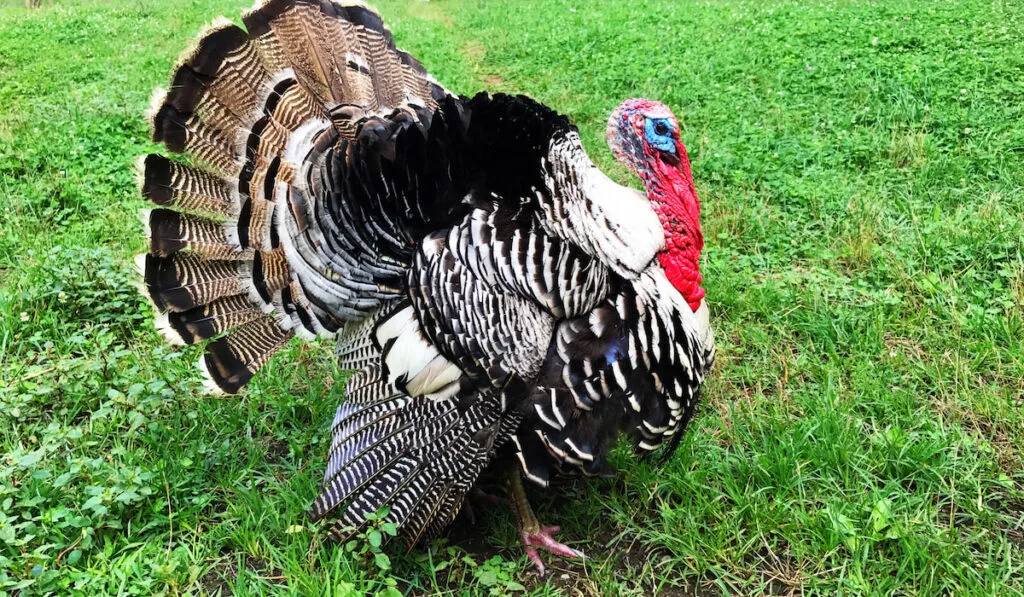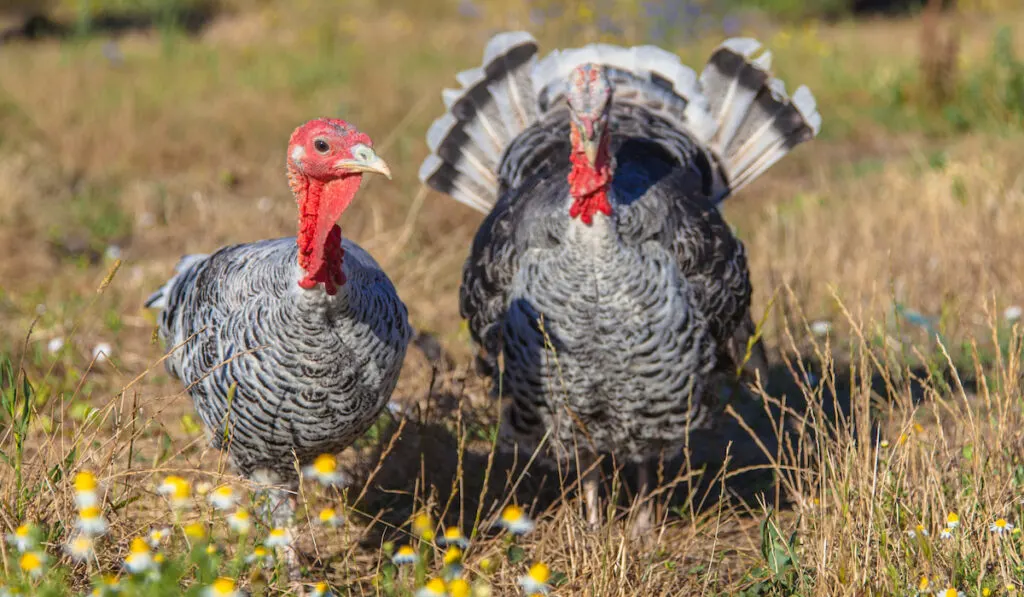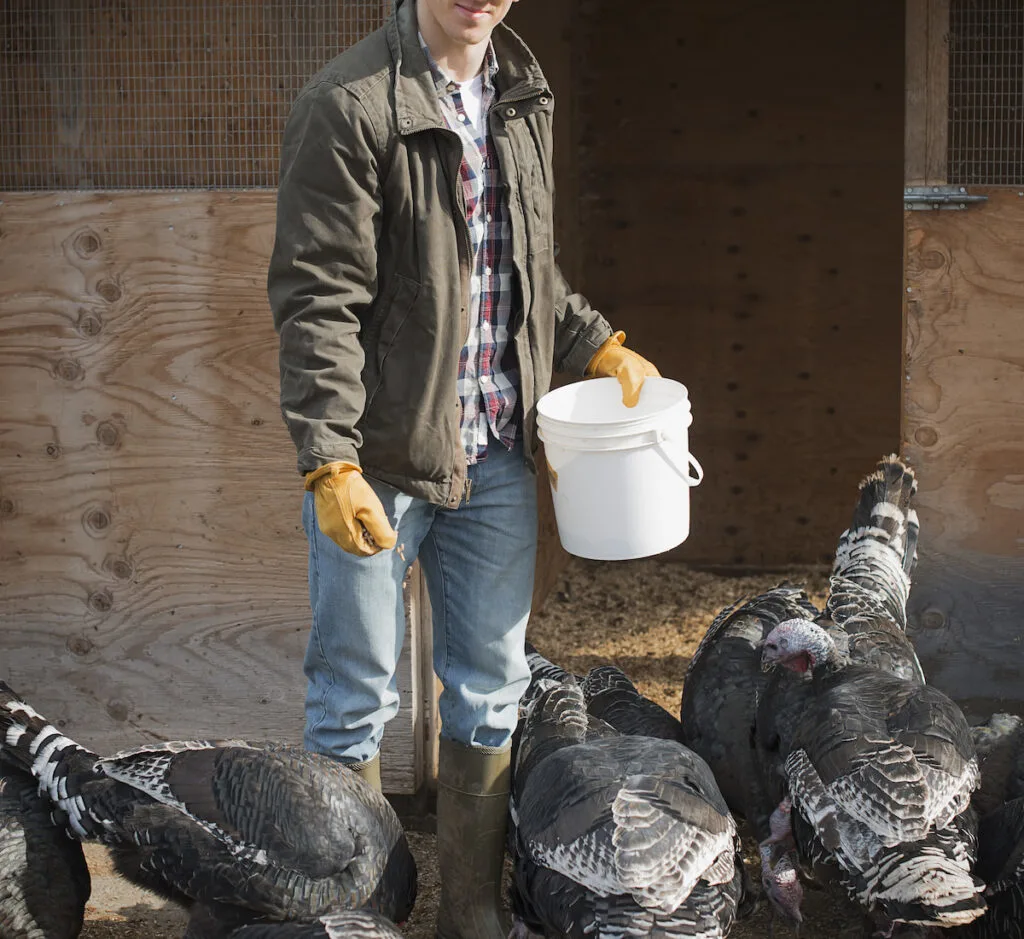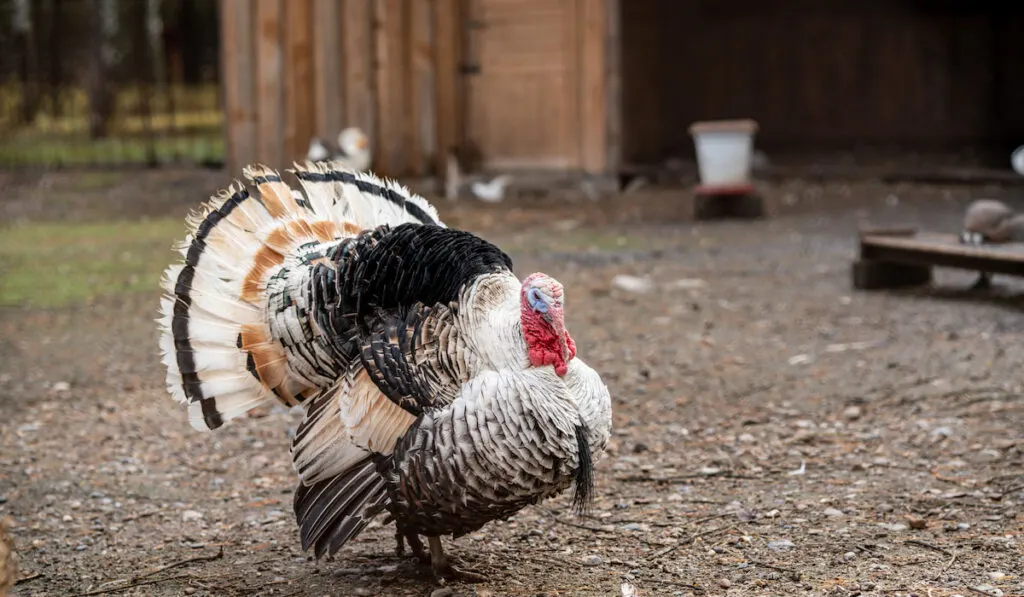If you are thinking of raising turkeys on your farm or homestead, there are specific things that you need to know. Raising turkeys can be very rewarding, but there are some things to consider.
To raise turkeys on your farm, you need to prepare their living space before the birds arrive. You should provide shelter, food, and water, heat lamps, bedding, and feeders.
Turkeys need more space than chickens; the coop, the nesting boxes, the run are all bigger. A large pen or small barn works well for turkeys. The more space you give them, the better turkeys do.

In this article, we guide you on all the steps to take to raise turkeys on your farm successfully. There are many tips here, so read on to know what exactly you need to do and how to prepare in advance.
Table of Contents
What Do Turkeys Need?
Here are some things to consider before choosing to raise turkeys on your farm.
- Turkeys are much larger than chickens; they require bigger housing.
- Turkeys need a secure coop and run to protect themselves from predators.
- Turkeys need quality feed.
- Turkeys need ground-level nesting boxes.
- Turkeys can fly, consider this when designing their pen or clip their wings.
- Turkeys need roosting bars.
Some Turkey Facts
- The Gobble. Turkeys have many sounds they use to communicate, like yelps, purrs, and kee-kees. Only male turkeys make the famous gobble sound call when it’s mating time. Because of this verbalization, male turkeys are called gobblers, and females are called hens.
- All wild turkeys can fly. It is often said that turkeys can’t fly, but they can fly up to 55 mph for short flights. The heavier domesticated turkeys don’t fly all that often. Farmyard turkeys have been known to fly up into a tree when chased. However, they are twice as heavy as a wild turkey.
- Wild turkeys roost in trees. All turkeys mostly live on the ground, but they will roost up in trees when it’s nighttime. Turkeys sleep in trees to protect themselves from predators; they roost at night and come down again in the morning.
- Turkey heads can change colors. Their heads can change color. An easy way to know how a turkey is feeling just look at the color of their heads. The head colors can change from blue to red to white; it depends on how agitated or relaxed they are—the brighter the colors, the stronger the emotions.
- You can tell a Turkey’s gender from its poop. If you want to know if it is a boy or girl, just check the poop. A male’s turkey’s poop is shaped like the letter J, while the female’s poop is spiral-shaped.
- Turkeys have great eyesight. Turkeys have great eyesight, almost three times better than a human. Turkeys’ eyesight covers 270 degrees, and they can see in color.
- A turkey’s snood is used for mating. The fleshy dangly appendage that lies over a turkey’s beak is called a snood. It is used for finding a mate. Females prefer males with longer snoods, according to some studies.
- Weighty birds. An adult gobbler can weigh 16 to 22 pounds and has a beard of modified feathers on his breast seven inches long. Gobblers have sharp spurs on their legs for fighting. Hens are smaller; they weigh 8 to 12 pounds and don’t have a long beard or spurs. Both genders have a snood and a wattle, the red dangly bit under the chin, and only a few tiny feathers on the head.
- Turkeys are fast; they can run at 25 miles per hour and fly as fast as 55 miles per hour.
- Eggs. Hens can lay 10 to 12 eggs, usually at one egg per day, for two weeks. She will incubate for about 28 days before hatching.
- Baby turkeys are called poults. They eat insects, seeds, and berries, while adult turkeys have a more varied diet, including acorns and small reptiles.
- Thanksgiving. Each year around 45 million turkeys are killed for Thanksgiving. Americans consume 1.5 billion pounds of turkey each year.
- Turkeys were not always so plentiful. The wild turkey population plummeted in the late 19th and early 20th centuries because of overhunting and habitat loss. In the 1940s, restoration efforts began and were very successful. Today wild turkeys have regained their numbers and even expanded their original range.
- Presidential pardons for turkeys started in 1989. It is thought that the first presidential pardon for turkeys happened when Abraham Lincoln’s son pleaded that the turkey intended for Christmas dinner, just like any other animal, had a right to live. However, it wasn’t until 1989 that the official pardoning ceremony began during President George H.W. Bush’s administration.
Requirements for Raising Turkeys

As soon as your turkeys are old enough to live outside, you should provide them with a roosting area with a roof that gives protection from predators. They also need access to fresh pasture.
The essential requirements for raising turkeys are:
- Protection from predators
- Places to dust-bathe
- Roosts to fly up into at night
- Access to range grass
- Adequate space: 75 feet by 75 feet is enough for 12 turkeys
The recommendations listed here for roosting structures and fenced pens work well when raising turkeys harvested for meat at 28 weeks of age.
Housing
Turkeys are healthy and happy when they have lots of space and a warm place to sleep at night, protecting them from the cold and rain. Turkeys require different fencing, housing, and pastures than chickens. They need a warm, secure shelter to roost in.
Make sure the turkey shelter has enough space per bird. There should be good ventilation to stop drafts.
A good space is two birds per three square feet with a perching space of 15 inches per bird. Barns or converted sheds and large coops are good roosting places.
Adult turkeys prefer staying outdoors. Turkeys are hardy and tolerant of many weather conditions. From the age of eight weeks onward, they can easily be kept outdoors for most of the year.
Before eight weeks, young turkeys should be kept in a brooder with access to an outdoor run.
When breeding, you need a more solid, permanent turkey coop. A small box or pen with solid sides makes a good place for a turkey hen to hatch out poults.
This box or pen can be placed within the larger turkey house. Divide the coop into at least two separate spaces to separate the males.
If your turkeys are free-ranging, they will generally come home to roost in their coop; however, at night, they will need a little more coaxing in the form of a bucket of food to get them back home.
Even when breeding turkeys, they need access to pasture every day. Half of an adult turkey’s diet is made up of plants and grasses from pasture.
The flooring in the turkey coop should be covered with a layer of sawdust or wood shavings but avoid hay or straw bedding as it absorbs the ammonia in the droppings. Hay can also contain harmful spores that can cause respiratory infections in all poultry.
If you bring new turkeys into the flock, ensure that you have an appropriate quarantine area to keep your existing turkeys safe from introduced diseases or pests.
Feeding Turkeys

Several specific turkey feeds are formulated to feed them through the several growth stages and prepare the turkeys for the market. Turkeys need a higher protein-based feed than other poultry to maintain their growth.
A turkey starter feed with a 24-28% protein content should be fed to the turkeys until they are 6-8 weeks old. They should then be fed a grower or finisher ration at this age, with a 20% protein content.
Gradually do this over two weeks. If you are raising turkeys for the table, keep the poults on the 20% protein feed until they are at optimum weight.
At pasture, turkeys are not picky eaters; they will eat seeds, acorns, grass seeds, berries, spiders, bugs, spiders, lizards, frogs, and other plants and small animals. They walk around mostly looking for their food on the ground.
Roosting Area
Turkeys need elevated roosting spots to sleep, with a roof shelter to protect them from rain, snow, and wind. You can build a single roost pen that has enough space for several birds. You can build a set of roosts or one, 5-by-8-foot roost that can house 20 turkeys.
It is a good idea to mount the roost or roost pen on wheels that will allow you to move it easily around. By moving the roosts around the range area, you prevent manure from building up in one place.
Wood is good construction material to keep the perch structure lightweight. However, don’t make the perch too lightweight to not blow over in the wind.
The perches should be 15 to 30 inches above the ground. If it is higher, place an angled ladder next to it to allow the birds to climb to the perch. You can cover the roost structure with a lightweight metal or fiberglass panel roof to protect the roosting birds from the weather.
Fencing

The fencing should be as high as possible, at least four feet. Turkeys can and will fly; to prevent this, you could also trim the wing feathers of rogue flyers.
Most turkeys will happily stay in the pen unless something disturbs them. If you plan to keep your turkeys in a pen, cover the pen with netting. It will protect the birds and prevent escapes.
Turkeys can be turned out to pasture with cows. They improve the land by eating weeds like nettles, dock, and chicory seeds. Turkeys further improve your pasture by picking out corn and other digested grains from manure and spreading it around your pasture.
Ensure your fencing is flush to the ground and strong enough to keep predators like raccoons, foxes, and weasels out. Turkeys are vulnerable to predation, particularly at night. Turkeys must be closed into their indoor coop before dark and should not be let out again until the sun is up in the morning.
Keep Rats Out
Other than the usual predators we might think of, you must protect your turkeys from rats. They have been known to injure turkeys by biting them when the turkeys sleep.
Rats are a big risk to your turkeys. Make sure you do everything necessary to keep rats away. Keep the turkey feed in well-sealed covered metal bins, and don’t leave spilled food on the ground.
Standardized Turkey Breeds
Here is a list of the most popular turkey breeds:

USA – American Standard of Perfection: Black, Bronze, Beltsville Small White, White Holland, Beltsville, Narragansett, Slate, Royal Palm, and Bourbon Red.
Britain – British Poultry Standards: Norfolk Black, Cambridge Bronze, Bronze, Crimson Dawn, British White, Slate, Bourbon Red, Buff, Narragansett, Pied, and Cröllwitzer.
Conclusion
Raising turkeys is effortless if you provide them with the necessities of a warm, secure coop, a safe place to roost, and a constant supply of fresh water and feed.
Apart from the space that raising turkeys need, turkeys are easier to keep than chickens. Turkeys are docile, regal birds; they create tight family bonds and are intelligent.
Turkeys like to roam, scratch in the ground, lay in the sun, and forage; make sure you provide your turkeys with enough outdoor space. It is important to keep predators in mind when building outdoor space for your turkeys.
Turkeys like to take a dust bath; this is a natural behavior that keeps them healthy and prevents external parasites. Create natural spaces that provide your turkeys ample opportunities to live a natural life.
Not only will this have a positive impact on your turkey’s overall quality of life, but it will also promote healthy flock dynamics.
If your farm is set up so you can raise turkeys, we encourage you to do so. Turkeys are amazing creatures, and though you might start your turkey flock to fill your freezer every fall, you will find that turkeys have wonderful personalities and make amazing pets.
